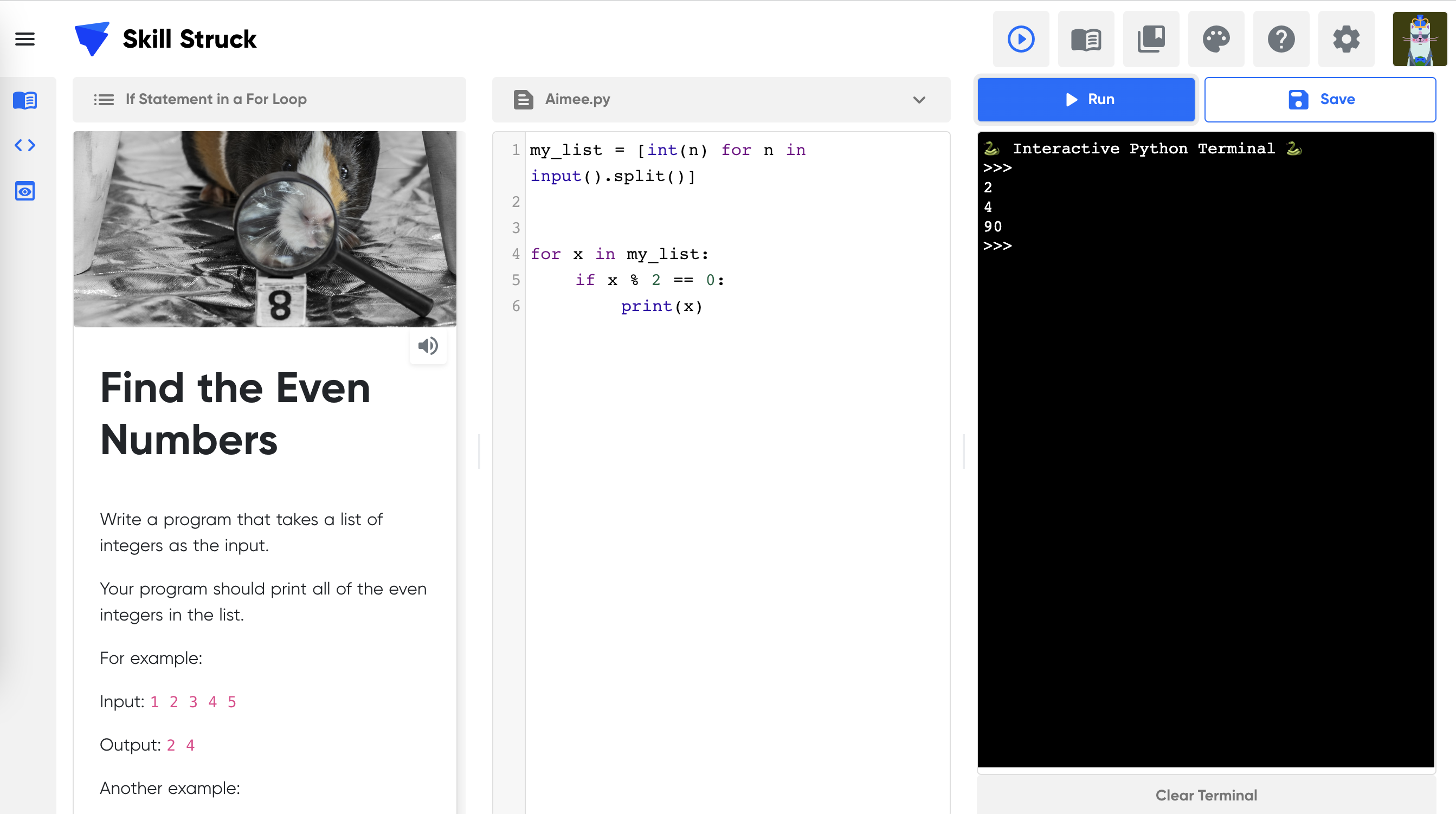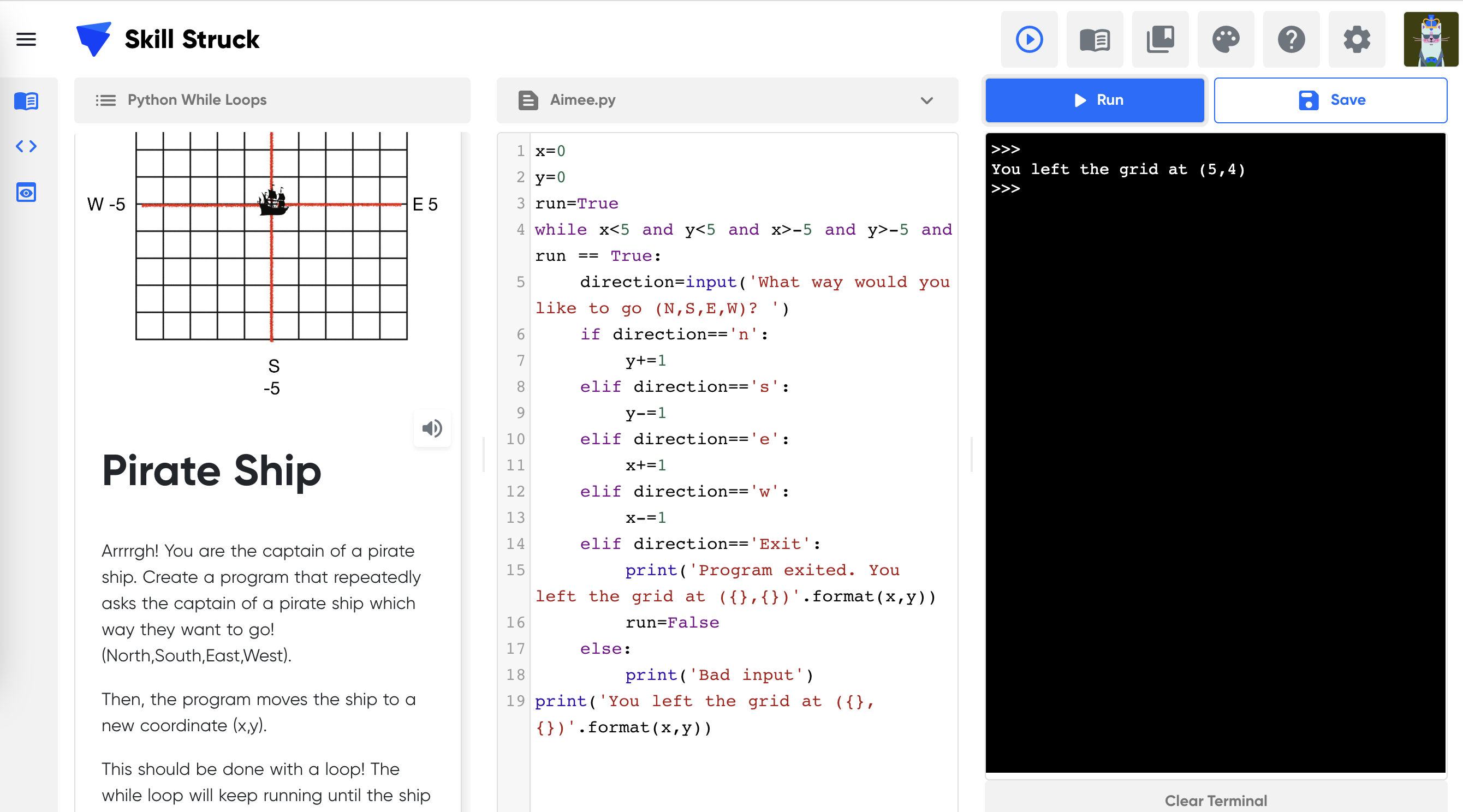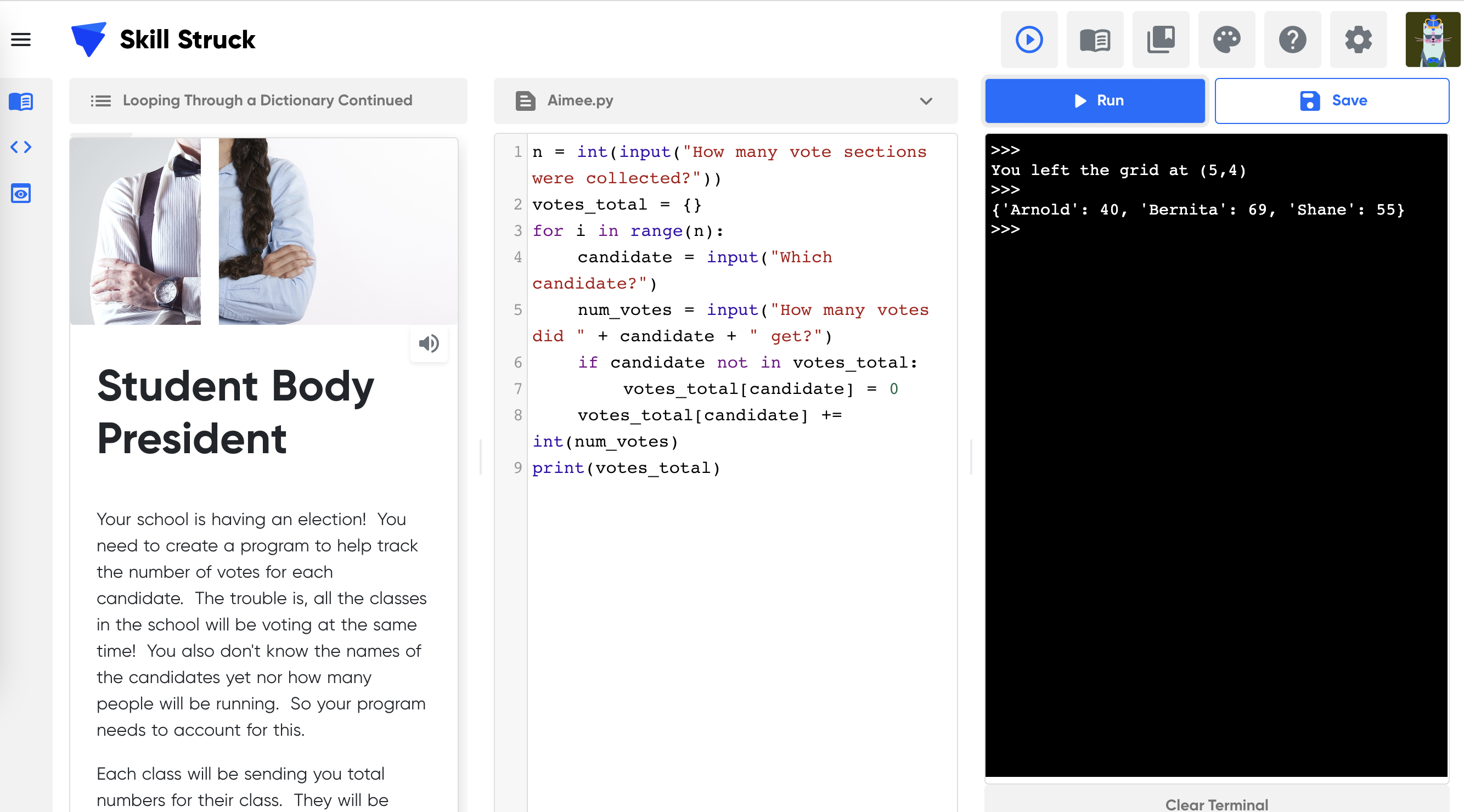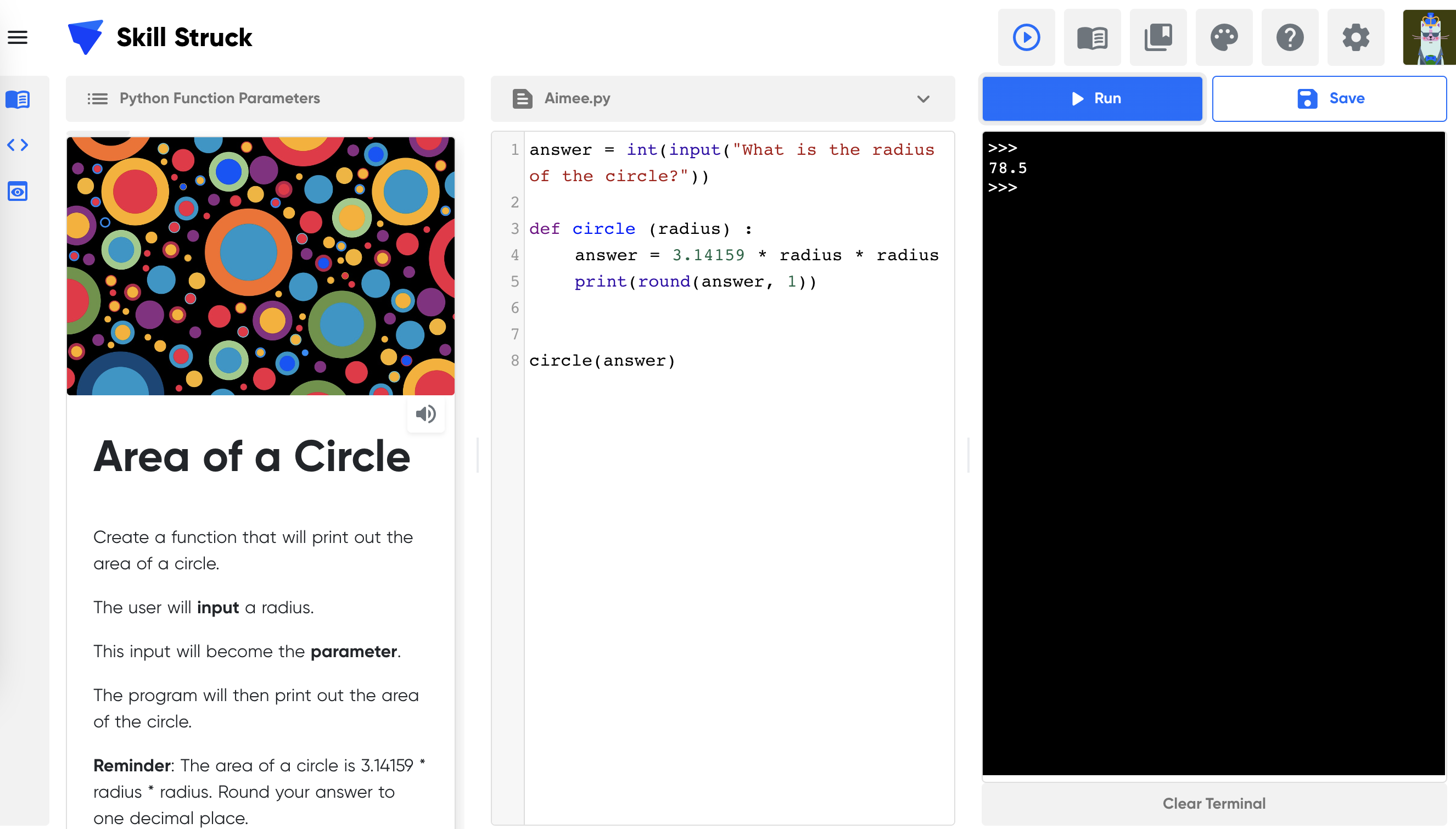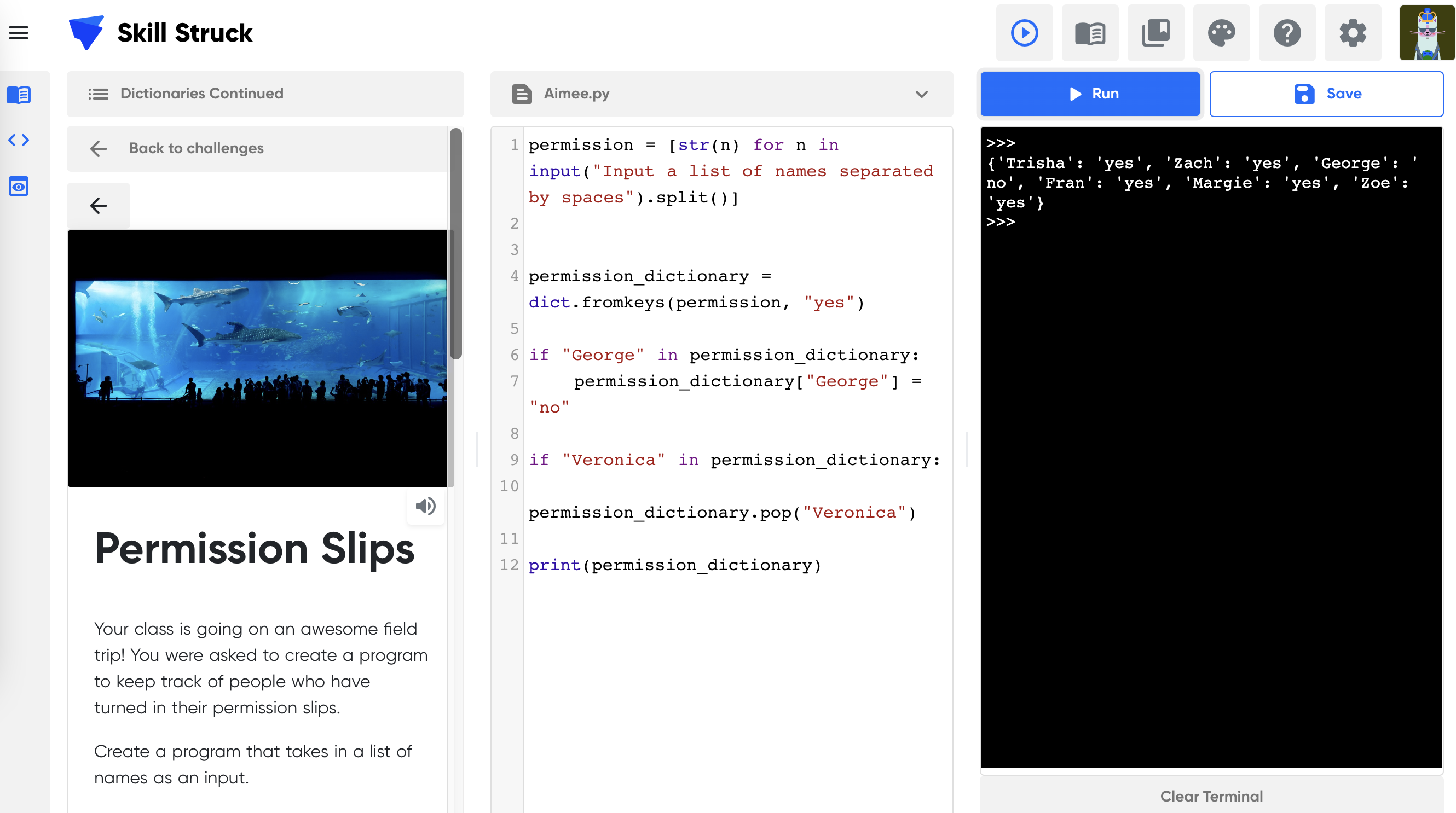FREE K-12 AI LITERACY COURSES FOR THE 2025-2026 SCHOOL YEAR! Learn more here.
- Skill Struck
- Course Catalog
- Python Coding Specialist Certification Prep
Python Coding Specialist Certification Prep
This course dives deep into Python concepts in order to prepare for the Knowledge Pillars PCS Certification.
78 Platform Lessons
Python
10th grade
11th grade
12th grade
Voyage
Python
Year
Industry Certifications
- Course Summary
- Course Outline
- Standard Alignment
- Course Project
In this course students will complete challenges that help solidify concepts as they use skills in a variety of ways. In order to complete tasks, students will creatively apply what they've learned by using different approaches to reach a goal. This experience closely follows challenges they would face in a technical interview, allowing them to practice. This course will prepare students to take the Knowledge Pillars PCS certification.

-
PCS: Introduction
Learning Outcomes:
Students are introduced to the Python language.
Topics covered:
Introduction
Standard alignment:
-
PCS: Variables
Learning Outcomes:
Students learn to add Variables to their Python programs.
Topics covered:
Variables
Standard alignment:
-
PCS: Input/Output
Learning Outcomes:
Students learn how to enter an input and generate an output in Python.
Topics covered:
Inputs
Outputs
Standard alignment:
-
PCS: Syntax & Comments
Learning Outcomes:
Students learn proper syntax rules and to add comments to their Python code.
Topics covered:
Comments
Standard alignment:
-
PCS: Variable Types
Learning Outcomes:
Students examine the different data types in Python.
Topics covered:
Data Types
Standard alignment:
-
PCS: Numbers
Learning Outcomes:
Students learn the rules of using numbers in Python.
Topics covered:
Numbers in Python
Standard alignment:
-
PCS: Converting
Learning Outcomes:
Students learn to convert between data types.
Topics covered:
Converting Data Types
Standard alignment:
-
PCS: Python Concatenation
Learning Outcomes:
Students learn to concatenate in Python,
Topics covered:
Concatenation
Standard alignment:
-
PCS: Python Math
Learning Outcomes:
Students learn rules to use Math in Python.
Topics covered:
Math
Standard alignment:
-
PCS: Modulus
Learning Outcomes:
Students learn what the modulus is and what it outputs.
Topics covered:
Modulus
Standard alignment:
-
PCS: Strings
Learning Outcomes:
Students learn specifics about using strings in Python,
Topics covered:
Strings
Standard alignment:
-
PCS: String Methods
Learning Outcomes:
Students are introduced to some basic methods to use with strings in Python,
Topics covered:
String Methods
Standard alignment:
-
PCS: String Methods Continued
Learning Outcomes:
Students continue to learn different methods to use with strings.
Topics covered:
String Methods
Standard alignment:
-
PCS: Checking Strings
Learning Outcomes:
Students learn to check if an item exists in a string.
Topics covered:
Checking Strings
Standard alignment:
-
PCS: Concatenating Numbers
Learning Outcomes:
Students learn the specifics about concatenating with numbers.
Topics covered:
Concatenating Numbers
Standard alignment:
-
PCS: Concatenating Numbers Continued
Learning Outcomes:
Students learn further details about concatenating numbers with strings.
Topics covered:
Concatenating Numbers
Standard alignment:
-
PCS: Lists
Learning Outcomes:
Students are introduced to lists in Python and how they are useful.
Topics covered:
Lists
Standard alignment:
-
PCS: Python If Statements
Learning Outcomes:
Students create if statements in their Python code.
Topics covered:
If Statements
Standard alignment:
-
PCS: Python Conditionals
Learning Outcomes:
Students add different conditionals and comparison statements to their if statements.
Topics covered:
Conditionals
Standard alignment:
-
PCS: Python Else If Statements
Learning Outcomes:
Students learn to further customize their if statements by adding else if statements in Python.
Topics covered:
Else If Statements
Standard alignment:
-
PCS: Python For Loops
Learning Outcomes:
Students learn to add a for loop to iterate through their lists.
Topics covered:
For Loops
Standard alignment:
-
PCS: Printing Specifics in Python
Learning Outcomes:
Students learn more advanced details about printing in Python,.
Topics covered:
Printing
Standard alignment:
-
PCS: If Statement in a For Loop
Learning Outcomes:
Students learn to add an if statement to a for loop.
Topics covered:
If Statements
Standard alignment:
-
PCS: Python Accessing Items in a List
Learning Outcomes:
Students learn how to access certain items that exist in a list.
Topics covered:
Accessing Items in Lists
Standard alignment:
-
PCS: Using Integers in a List
Learning Outcomes:
Students learn how to access and use integers that appear in a list.
Topics covered:
Using Integers in a List
Standard alignment:
-
PCS: Adding to Lists in Python
Learning Outcomes:
Students learn how to add items to a list in Python.
Topics covered:
Adding to Lists
Standard alignment:
-
PCS: Removing from Lists in Python
Learning Outcomes:
Students learn how to remove items from a list in Python.
Topics covered:
Removing from Lists
Standard alignment:
-
PCS: Python Lists Continued
Learning Outcomes:
Students learn further details about using lists in Python.
Topics covered:
Lists
Standard alignment:
-
PCS: Python While Loops
Learning Outcomes:
Students learn to add while loops to their Python code.
Topics covered:
While Loops
Standard alignment:
-
PCS: Python Functions
Learning Outcomes:
Students learn the rules for declaring and calling functions in Python.
Topics covered:
Functions
Standard alignment:
-
PCS: Python Function Parameters
Learning Outcomes:
Students learn how to add parameters to their Python functions,
Topics covered:
Function Parameters
Standard alignment:
-
PCS: Generator and Lambda Functions
Learning Outcomes:
Students learn how to add specific functions such as the generator and lambda functions to their Python code.
Topics covered:
Generator and Lambda Functions
Standard alignment:
-
PCS: Multiple Parameters in Python Functions
Learning Outcomes:
Students learn how to add more than one parameter to their Python functions.
Topics covered:
Parameters in Functions
Standard alignment:
-
PCS: Python Dictionaries
Learning Outcomes:
Students learn to add dictionaries to their Python code.
Topics covered:
Dictionaries
Standard alignment:
-
PCS: Adding to and Removing from Dictionaries
Learning Outcomes:
Students learn to manipulate the items in their Python dictionaries.
Topics covered:
Adding to and Removing from Dictionaries
Standard alignment:
-
PCS: Dictionaries Continued
Learning Outcomes:
Students learn further ways to work with Dictionaries in their Python code.
Topics covered:
Dictionaries
Standard alignment:
-
PCS: Looping through a Dictionary
Learning Outcomes:
Students learn how to add a loop that loops through the dictionaries in Python.
Topics covered:
Looping through a Dictionary
Standard alignment:
-
PCS: Tuples
Learning Outcomes:
Students learn how to use another data set called a Tuple in Python.
Topics covered:
Tuples.
Standard alignment:
-
PCS: Sets
Learning Outcomes:
Students learn how to add another data set in Python called a set.
Topics covered:
Sets
Standard alignment:
-
PCS: Reading Files
Learning Outcomes:
Students learn how to read txt files using Python code.
Topics covered:
Reading Files
Standard alignment:
-
PCS: Reading Parts of a File
Learning Outcomes:
Students learn how to read specific parts of a text file using Python.
Topics covered:
Reading Parts of a File
Standard alignment:
-
PCS: Append a Line to a Text File
Learning Outcomes:
Students learn how to add text to a txt file using Python code.
Topics covered:
Append a Line to a Text File
Standard alignment:
-
PCS: File Write Mode
Learning Outcomes:
Students learn how to use a certain mode in Python called hte File Write Mode.
Topics covered:
File Write Mode
Standard alignment:
-
PCS: Multi-dimensional Lists
Learning Outcomes:
Students learn to add lists that work in more than one dimension.
Topics covered:
Multi-dimensional Lists
Standard alignment:
-
PCS: Nested For Loops
Learning Outcomes:
Students learn how to put loops inside of loops.
Topics covered:
Nested For Loops
Standard alignment:
-
PCS: Iterating through 2D Lists
Learning Outcomes:
Students learn how to iterate through multidimensional lists.
Topics covered:
Iterating through 2D Lists
Standard alignment:
-
PCS: Recursion
Learning Outcomes:
Students learn how to implement simple recursion functions.
Topics covered:
Recursion
Standard alignment:
-
PCS: Recursion vs Iteration
Learning Outcomes:
Students examine the difference between recurision and iteration.
Topics covered:
Recursion vs Iteration
Standard alignment:
-
PCS: Python Random
Learning Outcomes:
Students learn how to use random in Python.
Topics covered:
Random
Standard alignment:
-
PCS: Python Math Library
Learning Outcomes:
Students learn how to access the Python Math Library.
Topics covered:
Math Library
Standard alignment:
-
PCS: Python Datetime
Learning Outcomes:
Students learn how to access the Python Datetime library.
Topics covered:
Datetime
Standard alignment:
-
PCS: Modules & Packages
Learning Outcomes:
Students learn how to add specific modules and packages available in Python.
Topics covered:
Modules & Packages
Standard alignment:
-
PCS: Object-Oriented Programming
Learning Outcomes:
Students are introduced to the basics of Object-Oriented programming.
Topics covered:
Object-Oriented Programming
Standard alignment:
-
PCS: Creating an Instance/Object
Learning Outcomes:
Studnets learn how to create their own objects in Python.
Topics covered:
Creating an Instance/Object
Standard alignment:
-
PCS: Objects Continued
Learning Outcomes:
Students learn further details about how to use objects in Python.
Topics covered:
Objects Continued
Standard alignment:
-
PCS: Super Classes
Learning Outcomes:
Students learn how to use super classes.
Topics covered:
Super Classes
Standard alignment:
-
PCS: Programming Languages
Learning Outcomes:
Students examine the differences between major programming languages.
Topics covered:
Programming Languages
Standard alignment:
-
PCS: Error Messages & Debugging
Learning Outcomes:
Students study different error messages and strategies for debugging.
Topics covered:
Error Messages & Debugging
Standard alignment:
-
PCS: Logical Thinking
Learning Outcomes:
Students learn how to use structured logical thinking to work through problems.
Topics covered:
Logical Thinking
Standard alignment:
-
PCS: Bitwise Operators
Learning Outcomes:
Students learn how to calculate different bitwise operator values.
Topics covered:
Bitwise Operators
Standard alignment:
-
PCS: Error Handling
Learning Outcomes:
Students learn how to set up structured error handling in their code.
Topics covered:
Error Handling
Standard alignment:
-
PCS: OS Path, Packets, & Modules
Learning Outcomes:
Students study the OS path along with packets and modules.
Topics covered:
OS Path, Packets, & Modules
Standard alignment:
Download the 2022 Skill Struck Standards Alignment + Correlation Guide to view a general list of our standard alignments, or find your state's specific alignment below:
Python Coding Specialist Certification Prep
In this course, students will complete challenges that help solidify concepts as they use skills in a variety of ways. In order to complete tasks, students will creatively apply what they've learned by using different approaches to reach a goal. This experience closely follows challenges they would face in a technical interview, allowing them to practice.
267 Student Activities
288 Teacher Resources
54 Checkpoints
2 Pre/Post Test
-
281 Quiz Questions
Autograder
English and Spanish
Skill Struck Reviews

Having a mapped out, structured way to learn and experience the Computer Science curriculum really freed up time for me to give students one-on-one attention. It also gave me more opportunities to give the students additional programming assignments to help them understand the concepts better.
Scott Couch
CS Teacher, Maeser Prep Academy

The program and the people behind it are innovative, intelligent, and organized. The platform is very user-friendly and l have been able to guide my students easily through the curriculum.
Dillon Gilpin
High School CS Teacher, Duchesne County School District

All of the content is fun and engaging for our students! Regarding the support and partnership, they are always on top of everything. Small issues are resolved quickly, and that is not typical with other EdTech companies.
Donna Woods
CTE Cyber Pathway Instructor, Moreno Valley United School District
